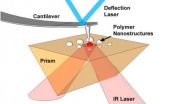New NIST time code to boost reception for radio-controlled clocks
2013-03-09
(Press-News.org) The National Institute of Standards and Technology (NIST) is changing the way it broadcasts time signals that synchronize radio-controlled "atomic" clocks and watches to official U.S. time in ways that will enable new radio-controlled timepieces to be significantly more robust and reliable.
This new time broadcast protocol will not only improve the performance of new radio-controlled clocks and watches, but will encourage the development of new timekeeping products that were not practical with the old broadcast system because of local interference or other limitations. For example, appliances such as refrigerators, microwave ovens and thermostats, as well as traffic light timers and sprinkler systems will be able to take advantage of this new phase modulation broadcast.
Popular radio-controlled timekeepers, which range from wristwatches to wall clocks, are not really atomic clocks—though that's often in their name—but they do set themselves by listening to low-frequency AM time broadcasts from the NIST radio station WWVB in Fort Collins, Colo. Those broadcasts are synchronized to the NIST atomic clock ensemble in nearby Boulder, Colo.
However, sometimes the radio-controlled clocks have difficulty accurately picking up the WWVB time signal because of the clock's location, local radio interference, effects of buildings, and other problems. Moreover, a time broadcast from England on the same frequency also interferes with devices on the east coast of the United States that rely on the NIST broadcast, according to John Lowe, station manager for WWVB.
To solve these problems, Lowe says, NIST has developed, tested and is now beginning to implement the new phase-modulation WWVB signal. Like a traditional AM radio station, time information is encoded in the WWVB broadcast by changes in the strength or amplitude of the radio signal. Phase modulation adds an additional layer of information encoded by shifting the phase of the carrier wave. (The crests of two waves that are "in phase" pass a point at the same time. If one is phase-shifted, the crest will arrive a little before or after the other.)
This change significantly improves signal reception and overall performance of new products that are designed to utilize this new protocol. Legacy clocks and watches will still continue to function as they have because the amplitude modulation remains the same, but they will not benefit from the increased performance of the new phase modulation protocol, Lowe said.
These new products and non-networked systems will be able to take advantage of the improved NIST broadcast format thanks to next generation receiver chips that will begin entering the marketplace in 2013.
INFORMATION:
For more on radio-controlled clocks work with WWVB, see http://www.nist.gov/pml/div688/grp40/radioclocks.cfm.
END
ELSE PRESS RELEASES FROM THIS DATE:
2013-03-09
HOUSTON - Endometrial cancer survivors are more likely to complete physical activity, and for longer durations, when their daily self-efficacy is higher, according to a study published online in the journal Health Psychology – a publication of the American Psychology Association.
"Sedentary behavior is associated with increased cancer risk, including endometrial cancer," said Karen Basen-Engquist, Ph.D., professor in the Department of Behavioral Science at MD Anderson and lead investigator on the study. "When cancer survivors exercise, it not only improves their physical ...
2013-03-09
To speed development and adoption of electronic health records (EHRs) for pediatrics, a group of experts from industry, academia and government convened by the National Institute of Standards and Technology (NIST) has focused its attention on three key audiences—records-system vendors and developers, small-group pediatric medical practices and children's hospitals.
In a paper* in The Joint Commission Journal on Quality and Patient Safety, the panel of medical, human factors engineering and software-usability experts detail how specific recommendations from a recent guide ...
2013-03-09
BUFFALO, N.Y. – A genetic mutation that alters the kinetics of an ion channel in red blood cells has been identified as the cause behind a hereditary anemia, according to a paper (http://bit.ly/13LgCzc) published this month in the Proceedings of the National Academy of Sciences by University at Buffalo scientists and colleagues.
The research team was led by Frederick Sachs, PhD, SUNY Distinguished Professor in the UB Department of Physiology and Biophysics, who discovered in the 1980s that some ion channels are mechanosensitive, that is, they convert mechanical stress ...
2013-03-09
Tiny biomolecular chambers called nanopores that can be selectively heated may help doctors diagnose disease more effectively if recent research by a team at the National Institute of Standards and Technology (NIST), Wheaton College, and Virginia Commonwealth University (VCU) proves effective. Though the findings* may be years away from application in the clinic, they may one day improve doctors' ability to search the bloodstream quickly for indicators of disease—a longstanding goal of medical research.
The team has pioneered work on the use of nanopores—tiny chambers ...
2013-03-09
Although biologists think that "new media" such as blogs and online social networks have an important influence on public opinion and political decisions, they aren't much inclined to use them themselves to stay informed about developments in science. Rather, they prefer traditional outlets such as newspapers and television. That seems, at least, to be the implication of a study published in the April issue of BioScience.
The study, by Joachim Allgaier of the Jülich Research Center in Germany and four coauthors, examined the opinions of 257 neuroscientists working in ...
2013-03-09
HOUSTON – (March 8, 2013) – A more rapid laboratory test for pregnant women to detect potentially deadly Group B strep (GBS) has been successful at identifying GBS colonization in six and a half hours, according to the results of a study from The University of Texas Health Science Center at Houston (UTHealth).
The more rapid test could be helpful for the 13 percent of patients who experience pre-term labor before they are screened for GBS, which usually occurs between 35 and 37 weeks of gestation. The current standard test takes 48 hours. Antibiotics can be administered ...
2013-03-09
Cyclone 19P in the Southern Pacific Ocean was renamed Sandra today, March 8, as NASA's Aqua satellite captured infrared data on the storm that indicated it would continue to strengthen. Residents of New Caledonia should prepare for impacts from Sandra early next week.
The Atmospheric Infrared Sounder (AIRS) instrument that flies aboard NASA's Aqua satellite captured an infrared image of Cyclone Sandra's cloud top temperatures on March 8 at 1717 UTC (12:17 p.m. EST). Strong thunderstorms around Sandra's center and in a band east of the center appeared as cold as -63 Fahrenheit ...
2013-03-09
For more than 20 years, researchers have been using atomic force microscopy (AFM) to measure and characterize materials at the nanometer scale. However AFM-based measurements of chemistry and chemical properties of materials were generally not possible, until now.
Researchers at the University of Illinois at Urbana-Champaign report that they have measured the chemical properties of polymer nanostructures as small as 15 nm, using a novel technique called atomic force microscope infrared spectroscopy (AFM-IR). The article, "Atomic force microscope infrared spectroscopy ...
2013-03-09
New technologies that exploit quantum behavior for computing and other applications are closer than ever to being realized due to recent advances, according to a review article published this week in the journal Science.
A silicon chip levitates individual atoms used in quantum information processing. Photo: Curt Suplee and Emily Edwards, Joint Quantum Institute and University of Maryland. Credit: Science.
These advances could enable the creation of immensely powerful computers as well as other applications, such as highly sensitive ...
2013-03-09
Custody and visitation rights for grandparents in Pennsylvania
Article provided by Palange & Endres, P.C.
Visit us at http://www.pandelaw.com
The bond between grandparents and grandchildren is important and special. In most cases, the survival of this relationship depends on the consent of the children's parents.
Sometimes -- perhaps because of estrangement, illness or divorce -- parents may limit grandparents' ability to spend time with their children. When this happens, grandparents may be able to go to court and seek protection of their grandparents' rights, ...
LAST 30 PRESS RELEASES:
[Press-News.org] New NIST time code to boost reception for radio-controlled clocks


